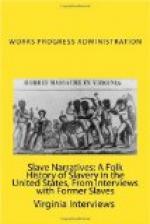“Right after the war, we farmed on shares. When we made our last share-crop, father farmed on Senator Bilbo’s mother’s farm on the State line. I nursed Senator Bilbo when he was a baby. Theoda Bilbo. He is the one who says Negroes should be sent to Africa. Then there wouldn’t be nobody here to raise people like him. He fell into the mill pond one day and I pulled him out and kept him from drowning. If it weren’t for that, he wouldn’t be here to say, ‘Send all the Negroes to Africa.’ If I’d see him right now, he’d give me ten dollars.
“Mrs. Bilbo’s first husband was a Crane. He killed himself. He didn’t intend to. It was in a horse race. The horse ran away with him and killed him. Then Theoda’s father married her. He was a poor man. He married that widow and got up in the world. They had a gin mill, and a grist mill, and a sawmill. They got business from everybody. That was Theoda’s daddy—old man Bilbo.
“In 1870, we stayed on Elisha McGhee’s farm. We called him Elisha but his name was Elijah. I began to remember them. The next year, we farmed for old man William Bilbo. But we didn’t get along so well there because daddy wouldn’t let anybody beat him out of anything that was his. That was Theoda’s gran’daddy. Then we went to (Mississippi) Miss Crane’s. The next year she married Theoda Bilbo’s daddy and in 1874, my daddy moved up on his own place at Hurricane Creek. There he built a church and built a school, and I went to the school on our own place. He stayed there till 1880. In 1880, we moved to Holly Springs. That was right after the yellow fever epidemic. I went to school there at Shaw University. I stayed in that school a good while. It’s called Rust College now. It’s named after the Secretary of the Freedman’s Aid Society. Rust was the greatest donor and they named the school after him. I went to the state school in my last year because they would give you a lifetime certificate when you finished there. I mean a lifetime teaching certificate for Mississippi. I finished the course and got the certificate. There is the diploma up there on the wall. J.H. Henderson was the principal and he was one of my teachers too. Henderson was a wonderful man. You know he died out here in the county hospital sometime ago. Sometime I’ll tell you all about him. He was a remarkable man. He taught there behind Highgate, a Northern man. I’ll tell you all about him sometime.
“I farmed with my father in the early part of my life. When I went to Holly Springs in 1881, I worked for Dr. T.J. Malone, a banker there, and a big farmer—President of the Holly Springs Bank. I worked for him mornings and evenings and slept at home of nights. I would work in vacation times too at whatever I could find to do till I got about able to teach. When I first commenced to teach, I taught in several counties—Lincoln, Simpson, Pike, Marion (the place I went to school), and Copiah. I built the school at Lawrence County. I organized the Folsom High School there. It was named after President Cleveland’s wife. I taught there nine years. I married there. My wife’s name was Narcissa Davis. She was a teacher and graduated from the same school I did. She lived in Calhoun County. She died in 1896, in Conway.




